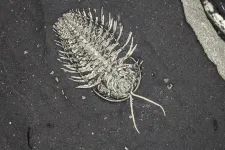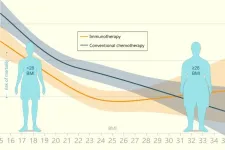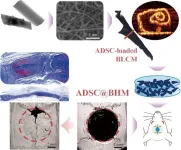(Press-News.org) Barcelona, 12 September 2024 – Immunotherapy has transformed cancer treatment in recent years by enabling the immune system to attack tumour cells. However, only 20-40% of patients respond positively to immunotherapy, and these rates vary across different types of cancer. Predicting which patients will respond to immunotherapy and which will not is currently a highly active area of research. Numerous studies conducted so far have focused on the specific characteristics of tumours, their microenvironment, or the patient's immune system. As a result, which of the proposed biomarkers represent the same underlying factors or how many independent factors influence the effectiveness of this therapy remains unclear.
Researchers at IRB Barcelona have identified five key, independent factors that determine patients' response and survival after receiving checkpoint inhibitors (CPIs), a type of immunotherapy widely used in cancer treatment. These findings, published in Nature Genetics, provide a reference framework for current and future biomarkers of immunotherapy response. They could also, in the future, entail a pathway to a significant advancement in the personalisation of cancer treatments, helping to more accurately identify those patients who are likely to benefit from immunotherapy. The results suggest that patients with certain types of tumours, who are currently not considered candidates for immunotherapy (such as those with liver or kidney carcinomas) might benefit from this type of treatment.
The team led by Dr. Núria López-Bigas and Dr. Abel González-Perez, from the Biomedical Genomics laboratory at IRB Barcelona, in collaboration with researchers from several international centres, has addressed this issue through a comprehensive analysis of genomic, transcriptomic, and clinical data from 479 patients with metastatic tumours, who received CPI treatment. These data are from a public database generated by the Dutch Hartwig Medical Foundation.
"We used an unbiased approach to analyse thousands of molecular and clinical features and identified five independent factors that influence response to immunotherapy and patient survival," explains Dr. López-Bigas, ICREA researcher at IRB Barcelona.
Five factors, five keys to immunotherapy
The five factors identified are: tumour mutational burden; effective T cell infiltration; the activity of transforming growth factor beta (TGF-β) in the tumour microenvironment; previous treatment received by the patient; and tumour proliferative potential. These factors in different types of cancer are associated with the response to CPIs and have been validated by the authors in six independent cohorts, covering a total of 1,491 patients.
Tumour mutational burden (TMB): Tumours with a high number of mutations tend to produce more neoantigens, making it easier for the immune system to recognise and attack them. TMB has been one of the most studied biomarkers for predicting response to CPIs.
Effective T-cell infiltration: The presence of cytotoxic T-cells in the tumour is essential for the effectiveness of CPIs. This study has confirmed that a higher infiltration of these cells is directly related to a better response to the therapy.
TGF-β activity in the tumour microenvironment: This factor influences the behaviour of some cells in the tumour microenvironment. High TGF-β activity can suppress the immune response, which is reflected in a tendency for patients to have poorer survival after immunotherapy treatment.
Previous treatment: Patients who have received previous treatments tend to show a poorer response to immunotherapy.
Tumour proliferative potential: Patients with tumours that have a high proliferative index, which tend to be more aggressive, generally show poorer survival after treatment.
Towards personalised cancer treatment
These five factors provide a framework for organising the vast current knowledge about biomarkers of immunotherapy response. "So far, many studies have focused on identifying and reporting individual biomarkers, but our results suggest that many of these biomarkers might be different versions of the same underlying factors,” says Dr. González-Pérez.
Furthermore, the researchers demonstrated that a multivariate model combining these five factors allows for more accurate patient classification than using tumour mutational burden alone ( as is frequently done in clinical practice), predicting the probability of patients to respond to immunotherapy. This advance could have significant clinical implications in the future, as it could prevent patients with a low likelihood of response from experiencing the side effects of CPIs, which can lead to autoimmune diseases, and could also help reduce the cost of treatments.
Validation in international cohorts
One of the highlights of this study is the validation of these five factors in six independent cohorts of patients with cancers such as lung, colon and melanoma. "We have confirmed that these factors are relevant in different types of cancer and different patient populations, thus reinforcing their clinical value. As research continues, new latent factors may be discovered in other types of cancer or larger cohorts," explains Dr. Joseph Usset, a former postdoc at IRB Barcelona who is now at the Vall d’Hebrón Institute of Oncology.
The team hopes to have a larger volume of patient data in the future to create more accurate models. The accuracy of these models for potential future clinical application should be validated through prospective clinical trials. However, this advancement faces a significant challenge, namely the difficulty accessing data as comprehensive and detailed as that used in this study.
"This study represents an important step in understanding how different tumour characteristics influence treatment response. In the future, we hope that these five factors will be integrated into clinical practice to guide therapeutic decisions," concludes Dr. Lopez-Bigas.
This study has been possible thanks to the collaboration of the Vall d’Hebron Institute of Oncology (VHIO), the Hartwig Medical Foundation in Ámsterdam, the Centro de Investigación Biomédica en Red en Cáncer (CIBERONC) at the Instituto de Salud Carlos III, the Center for Molecular Medicine at the University Medical Center of Utrecht, the Princess Margaret Cancer Centre at the University of Toronto, and the Pompeu Fabra University in Barcelona.
The work has received funding from the Excellence Programme of the Spanish Association Against Cancer (AECC), the European Research Council, the Horizon programme of the European Commission, the Ministry of Science and Technology, and the Government of Catalonia.
END
Five key factors predict the response of cancer patients to immunotherapy
2024-09-12
ELSE PRESS RELEASES FROM THIS DATE:
Trilobite fossils from upstate New York reveal “extra” set of legs
2024-09-12
A new study finds that a trilobite species with exceptionally well-preserved fossils from upstate New York has an additional set of legs underneath its head. The research, led by the American Museum of Natural History and Nanjing University in China, suggests that having a fifth pair of head appendages might be more widespread among trilobites than once thought. Published today in the journal Palaeontology, the study helps researchers better understand how trilobite heads are segmented.
Trilobites are ...
Big algebras: A dictionary of abstract math
2024-09-12
Several fields of mathematics have developed in total isolation, using their own ‘undecipherable’ coded languages. In a new study published in PNAS, Tamás Hausel, professor of mathematics at the Institute of Science and Technology Austria (ISTA), presents “big algebras,” a two-way mathematical ‘dictionary’ between symmetry, algebra, and geometry, that could strengthen the connection between the distant worlds of quantum physics and number theory.
Technical Toolkit: Symmetry and commutativity, from esthetics to functionality
Symmetry is not just a question of esthetics and equilibrium, but also a highly recurrent feature throughout the domains ...
BMI’s relation to cancer therapy mortality risks not so straightforward
2024-09-12
While being overweight increases the risk of developing lifestyle-related diseases, there is a phenomenon known as the obesity paradox where a decreased risk of death has been seen during cancer therapy. However, that paradox might not be the trend for all cancer therapies, an Osaka Metropolitan University team reports in JAMA Network Open, a publication of the American Medical Association.
Led by graduate student Mr. Yasutaka Ihara and Professor Ayumi Shintani of the Graduate School of Medicine’s Department of Medical Statistics, ...
Kids in families with too much screen time struggle with language skills
2024-09-12
Screens have become ubiquitous in our daily lives — which means they’ve also become part of children’s lives too. So what effect does this have on children’s developing brains, especially critical language skills? To understand this, scientists in Estonia surveyed the parents of more than 400 children about their screen use, their children’s screen use, and their children’s language skills. They found that parents who use screens a lot also have children who use screens a lot, and that children’s higher screen time is associated with poorer language skills.
“Our ...
Medical College of Georgia scientists searching for new treatment target for diabetic retinopathy
2024-09-12
Scientists at the Medical College of Georgia at Augusta University are searching for a new treatment target for a common complication of diabetes that can cause retinal blood vessels to break down, leak, or become blocked.
Diabetic retinopathy is a serious eye disease and a leading cause of blindness that results when diabetes’ sustained high blood sugar levels cause damage to the retina – the part of the eye that detects light – over time. That can happen in a number of ways, from inflammation to overgrowth ...
High doses of some prescription stimulants tied to increased psychosis risk
2024-09-12
Prescribing rates for stimulants that treat attention-deficit/hyperactivity disorder (ADHD) have increased significantly over the past decade, with some of the largest increases reported during the COVID-19 pandemic. A new study of adult emergency department admissions at Mass General Brigham, led by McLean Hospital researchers, found that individuals who are taking high doses of amphetamine (e.g. Adderall) face more than a five-fold increased risk for developing psychosis or mania. Findings were published September 12th in the American Journal of Psychiatry.
Overall, individuals with past-month prescription amphetamine use had a greater likelihood of new-onset psychosis or mania ...
New national survey shows hesitancy about vaccines this fall
2024-09-12
With flu season just around the corner and COVID-19 cases on the rise, a new nationwide survey from The Ohio State University Wexner Medical Center reveals hesitancy around vaccines this fall. The new data comes just as this year’s flu shot rolls out and following the FDA’s approval of an updated round of COVID-19 vaccines.
The national poll of 1,006 people found more than one-third (37%) have gotten vaccines in the past but do not plan to this year. The same percent of respondents said they don’t need any of the vaccines surveyed in the poll, including flu, COVID-19, pneumococcal and respiratory ...
Revolutionary tubular scaffolds boost stem cell-driven bone regeneration in skull defects
2024-09-12
Scientists from Sun Yat-sen University's School of Biomedical Engineering have developed groundbreaking tubular scaffolds made from electrospun membranes, which significantly enhance bone regeneration in critical skull defects. These scaffolds, designed to mimic natural bone structures, create an ideal environment for adipose-derived stem cells (rADSCs) to thrive and accelerate healing. By integrating advanced materials like polycaprolactone, PLGA, and nano-hydroxyapatite, the researchers achieved remarkable results in both lab and animal studies, ...
UTokyo attosecond institute welcomes Nobel laureate
2024-09-12
Nobel laureate Pierre Agostini, winner of the 2023 prize in physics, will headline a special two-day event hosted by the University of Tokyo on Sept. 26-27. The keynote lecture by Agostini, renowned for this pioneering work in attosecond science, will be part of a larger symposium bringing together researchers from around the world to celebrate the university’s planned Attosecond Laser Facility (ALFA), and discuss the latest developments and future directions of attosecond science.
Have you taken a photo of a fast-moving animal or vehicle and noticed how blurry the subject can be? This is likely because the faster a moving subject is, the faster the camera’s shutter needs ...
Single dose of mpox vaccine effective in preventing infection, study finds
2024-09-11
Toronto, ON, September 11, 2024 — A single dose of the Modified vaccinia Ankara-Bavarian Nordic (MVA-BN) was 58% effective in protecting again mpox infection, according to a new study published in BMJ.
Researchers from ICES, Public Health Ontario, and the MAP Centre for Urban Health Solutions at St. Michael’s Hospital of Unity Health Toronto have conducted a target trial emulation to estimate the effectiveness of the mpox vaccine.
During the mpox outbreak in 2022, Ontario, Canada introduced the vaccine ...





